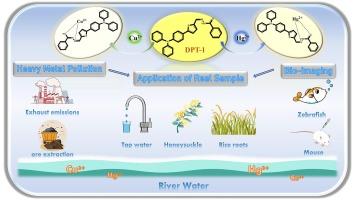基于三苯胺的双功能特异性荧光生物传感器,用于 "关闭 "铜和汞的识别:在实际样品和生物系统中的应用。
IF 4.6
2区 化学
Q1 SPECTROSCOPY
Spectrochimica Acta Part A: Molecular and Biomolecular Spectroscopy
Pub Date : 2024-12-20
DOI:10.1016/j.saa.2024.125621
引用次数: 0
摘要
准确监测实际样品和生物系统中Cu2+和Hg2+的含量,对保障食品安全和人体健康具有重要意义。因此,开发同时检测Cu2+和Hg2+的高效方法,在生物和实际样品中具有重要意义。本文设计并合成了一种以三苯胺为原料的双功能比例比色荧光生物传感器DPT-1,通过“关闭”荧光,特异性地同时检测Cu2+和Hg2+不同程度的荧光猝灭。此外,DPT-1还能有效检测自来水、松花江水和金银花提取物等多种实际样品中的Cu2+和Hg2+。此外,DPT-1在水稻根、活细胞和斑马鱼中对Cu2+/Hg2+的检测表现优异。随着研究的进展,本文概述的发现为食品安全监测和生物学研究提供了广泛的潜力。本文章由计算机程序翻译,如有差异,请以英文原文为准。

A dual-functional specific fluorescent bio-sensor based on triphenylamine for “turn-off” recognition of copper and mercury: Application in real samples and living system
Accurately monitoring the content of Cu2+ and Hg2+ in real samples and biological systems is of great significance in ensuring food safety and human health. Therefore, developing efficient methods for simultaneously detecting Cu2+ and Hg2+ is of great significance in living organisms and real samples. In this work, a bifunctional ratiometric and colorimetric fluorescent bio-sensor DPT-1, was designed and synthesized using triphenylamine to specifically and concurrently detect Cu2+ and Hg2+ exhibited varying degrees of fluorescence quenching through “turn-off” fluorescence. Furthermore, DPT-1 effectively detected Cu2+ and Hg2+ in various real samples, encompassing tap water, Songhua River water, and honeysuckle extract. In addition, DPT-1 exhibited remarkable performance in detecting Cu2+/Hg2+ in rice roots, living cells and zebrafish. As research progressed, the discoveries outlined in this article offered the versatile potential for holding promise for food safety monitoring and biological research.
求助全文
通过发布文献求助,成功后即可免费获取论文全文。
去求助
来源期刊
CiteScore
8.40
自引率
11.40%
发文量
1364
审稿时长
40 days
期刊介绍:
Spectrochimica Acta, Part A: Molecular and Biomolecular Spectroscopy (SAA) is an interdisciplinary journal which spans from basic to applied aspects of optical spectroscopy in chemistry, medicine, biology, and materials science.
The journal publishes original scientific papers that feature high-quality spectroscopic data and analysis. From the broad range of optical spectroscopies, the emphasis is on electronic, vibrational or rotational spectra of molecules, rather than on spectroscopy based on magnetic moments.
Criteria for publication in SAA are novelty, uniqueness, and outstanding quality. Routine applications of spectroscopic techniques and computational methods are not appropriate.
Topics of particular interest of Spectrochimica Acta Part A include, but are not limited to:
Spectroscopy and dynamics of bioanalytical, biomedical, environmental, and atmospheric sciences,
Novel experimental techniques or instrumentation for molecular spectroscopy,
Novel theoretical and computational methods,
Novel applications in photochemistry and photobiology,
Novel interpretational approaches as well as advances in data analysis based on electronic or vibrational spectroscopy.

 求助内容:
求助内容: 应助结果提醒方式:
应助结果提醒方式:


